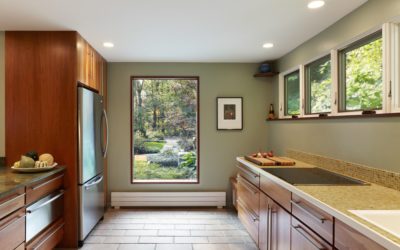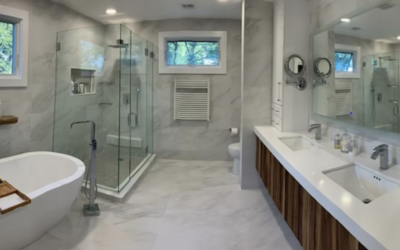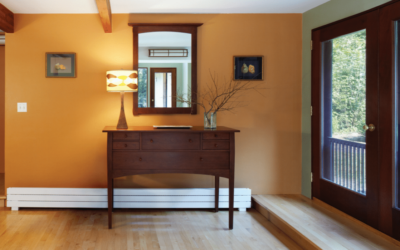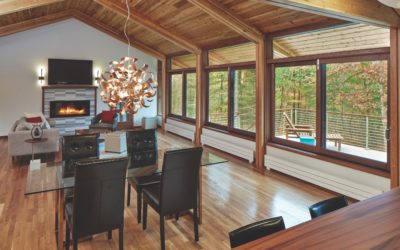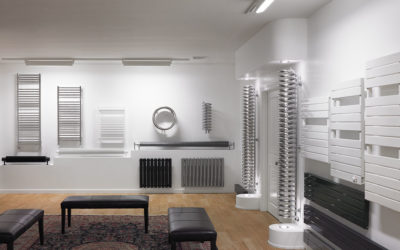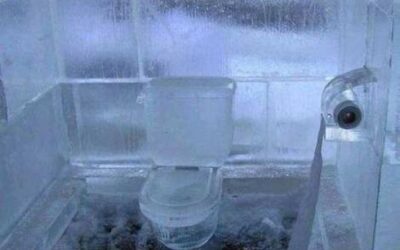Learning Center & FAQ
What makes Runtal Radiators the best choice?
Premium design, maximum efficiency, and ultimate comfort, just to name a few. Watch our video to learn more about what makes Runtal Electric Radiators the prime choice for heating your home.
Runtal Radiators Featured on “How It’s Made”
The following video was featured on Discovery’s Science Channel “How It’s Made” program on January 17, 2019. The segment titled European Style Radiators features the unique production process for Runtal Radiators including both Electric and Hydronic versions of their Baseboard, Wall Panel and Omni Panel II Tower Radiator products.
Frequently Asked Questions
1) How are these different from products like traditional electric baseboard, like what I find at Big Box Stores?
Runtal Electric Baseboards and Wall Panels are very different from the traditional electric baseboard design. Most, if not all baseboard products on the market consist of several pieces which snap together
Sheet Metal back plate
Front cover which snaps on to the backplate (Usually the sheet metal is very light gauge 22ga (thin).
Heating element is hung inside the enclosed cavity made by the backplate and front cover.
In some cases, the backplate and front cover are made from plastic rather than thin sheet metal.
Runtal Electric Baseboard and Wall Panels are one solid unit constructed of heavy gauge (16 GA) fully welded steel. The entire unit is then powder coat painted for an elegant and extremely durable finish.
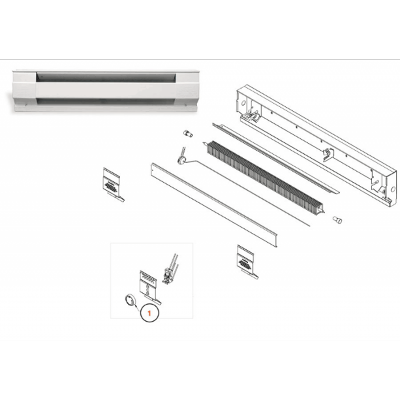 |
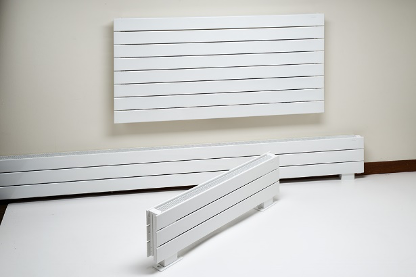 |
| Traditional Sheet Metal Electric Baseboard | Runtal Electric Baseboard and Wall Panels – Fully Welded, One-Piece Design |
2) Are they more efficient than traditional baseboard
Runtal Electric units are 100% efficient. What this means is that 100% of the electric energy used is converted into heat. Traditional baseboard products utilize lightweight construction which does not hold heat. As a result, when the room temperature is reached, they turn off and stop transmitting warmth into space whereas Runtal Electric products “store heat” because of the heavy steel construction which continues to radiate heat well after the room temperature has been satisfied. As a result, Runtal Electric Baseboard and Wall Panels do not have to continue to cycle on and off like a traditional electric baseboard product would do.
3) How do they heat? Are they filled with water?
Runtal Electric Baseboard and Wall Panels utilize what is called a Mica Insulated Strip Finned (MISF) heating element. This high-tech element requires no fluid filled tubes or pipes because the element is secured in direct contact with the heavy-duty metal radiator body. The MISF element is 100% efficient, transferring all of its electrical energy into heat which is in direct contact to the radiator surface. This direct contact efficiently heats up the heavy mass of the welded steel body of the unit and produces radiant (like standing in the sun) heat along with convective heat flow (Aero fins on the back of the unit provide natural heated air flow because hot air rises)
In some traditional electric baseboard products, the element (separate from the enclosure) contains an antifreeze or “oil” fluid. When electricity is applied, a rod like element encapsulated in the fluid gets hot and heats the fluid which then heats the fins on the pipe, which then heats the air. Traditional baseboard has NO radiant effect. All of the heat to the room is transfer by convection (hot air rises).
4) How much does it cost to run?
Operating costs vary based on your electricity costs, and the region of the country you are located in. Compared to standard electric baseboard, Runtal products will generally require the same amount of electricity to operate, however based on the heavy steel construction and the radiant effect which Runtal Electric Baseboard and Wall Panels provides, they will need to be energized (operate) less often for two reasons as shown below. In this regard, less operating time = less energy used to reach comfort.
Once the Runtal electric Baseboard heats up, the heavy steel body of the baseboard acts as a “heatsink”, storing heat.
Runtal Electric Baseboard operates by using both radiant heat transfer, as well as convective heat transfer. The radiant effect (like standing in the sun) often means comfort levels are reached at lower air temperatures, and thus requires less energy to be comfortable than products which heat only the air in the space.
5) Why do they cost more than standard electric baseboard?
Runtal Electric Baseboard and Wall Panels are completely different from standard electric baseboard products in construction, durability, and quality finish and are not directly comparable. For more information on construction and operating differences please see answers to questions 1 through 4.
Concerning product fit and finish there is no product currently on the market which can match the design beauty and quality of the Runtal product line.
6) How many feet would I need to heat a room?
Depending on what area of the country you live in, and how the room is constructed and what your specific design requirements are, we can offer you a perfect solution for both comfort and architectural beauty from our collection of Runtal Electric Baseboard, Wall Panels or Towel Radiators.
Please give us a call at 1-800-526-2621 or contact us at customer.service@runtalnorthamerica.com and one of our expert sales and application designers will be happy to assist you.
7) Do they have an integral thermostat?
Runtal Electric Baseboard and Wall Panels do not have an integral thermostat. Unit mounted thermostats are not recommended for proper room comfort levels. Rather we recommend the Runtal Smart Thermostat (RST), which is fully Wi-Fi enabled and can be programmed for the ultimate room comfort and operating efficiency.
The reason unit mounted thermostats are not recommended is because the thermostat will measure the temperature in which it is located, in this case directly on the unit. This will mean that only the area directly around the unit will remain warm, whilst the rest of the room will be cold.
8) Are they available in plug in versions?
No, Runtal Electric Baseboard and Wall Panels require direct hard wiring. For replacement of existing baseboard, in most cases the Runtal Electric products can utilize the existing wiring. (Note: Although it is a fairly simple job, we strongly recommend that a certified electrician wire the products in order to meet local building and electric codes. All Runtal Electric products are UL/CSA certified.
9) Which voltage do I want?
This will depend on the existing voltage which your building currently utilizes. Runtal Electric Baseboard and Wall Panels are available in 120V, 240V and 208V models.
10) How do I know what size I need?
See question and answer 6
11) Is there a suggested thermostat?
See question and answer 7
12) How hot to the touch do they get?
Under normal conditions (room temperature 50F to 85F degrees) Runtal Electric Baseboard will reach 140 degrees F and Wall panels will reach a surface temperature of 160 to 180 degrees F.
13) Will my drapes get scorched?
No, your drapes will not scorch. We recommend no less than 2″ of clearance between any object (furniture, curtains) to avoid direct contact with the Runtal Electric Baseboard or Wall Panels.
14) Can I put them behind the furniture?
Yes, however be sure to maintain at least 2″ of clearance between the surface of the Runtal Electric Baseboard or Runtal Electric Wall Panel.
15) Do they make noise?
NO – Runtal Electric Baseboard and Electric Wall Panels operate with no noise at all. When first installed and energized you may hear some “ticks” as the unit expands, however all of our products are fully tested prior to shipment, therefore any expansion should have already been set at the factory.
16) What’s the difference between the Wall Mounted Baseboard Series and the Free-Standing Baseboard Series
Runtal Electric Baseboard is available in two different mounting styles:
Wall Mounted – Runtal Electric Wall Mounted products are designed to be fixed to the wall, similar to traditional baseboard. Because the product is heavy, the weight is supported on each end by small boxes “feet” which also serve as the wiring connection points for the unit.
Freestanding – Runtal Electric Freestanding Baseboard (sometimes referred to as Pedestal Mounted) does not need a wall to support it. The Freestanding Series is secured to the floor rather than the wall, which allows for applications where a wall surface is not present. For example, in the case of floor to ceiling windows. The Freestanding Series comes in two parts:
The electric baseboard itself.
The Pedestal Mounting system.
This Pedestal Mounting system is actually a “false” back which is constructed in exactly the same way the baseboard product is (fully welded and looks exactly the same as the baseboard). With this Series, the baseboard has two completely finished sides so when viewed from either side, it is a fully finished unit.
17) Which Runtal Electric model is right for me?
Choosing which Runtal Electric product works best for you is a balance of heating performance and architectural preference. No matter what your design objectives are, Runtal Electric Products can meet your need.
Runtal Electric Baseboard
Runtal Electric baseboard is suitable for any area of the house where lower wall space is available. Favorable locations are on the outside walls, below any windows.
Runtal Electric Free-Standing Baseboard
Runtal’s exclusive Free-Standing Baseboard model can be installed anywhere in your room where wall space is not available or suitable for mounting. The Free-Standing Baseboard is mounted directly to the floor and is supported by our exclusive and robust pedestal design. The pedestal mounting system provides a complete finished back to the EB 3 baseboard model, so it is beautiful when viewed from either the front or the back. Ideal for rooms with floor to ceiling windows.
Runtal Electric Wall Panels
Our Swiss heritage comes out in the Wall Panel design. As seen, all over Europe, the Wall Panel design provides an option where “low and long” will not work well with your room design, or space is limited. Wall Panels are typically mounted in proportion to the room’s windows and just below the window for effective heat distribution. Perfect for older homes with tall windows, refurbished apartments/condominiums as in the regentrification of downtown projects, and as a replacement for anywhere old steam /water cast iron radiators where installed.
18) How much heat do I need in my space?
Generally, most spaces will require 10 Watts (35 BTU/H) per square foot area of the space. Using this as a baseline and evaluating the considerations below will give a solid idea of the heating requirements.
To calculate the baseline requirement:
1) Room width x room length = Square foot area
2) Square foot area x 10 = total watts of heat required
Example:
Room width = 12 Feet
Room Length = 12 feet
12 x 12 = 144 Square Feet
144 x 10 = 1440 Watts
This result is the total amount of heat required to properly heat the space.
3) Selecting the product, you want:
If there is available space along an outside wall with windows, our EB3 Wall Mounted Baseboard is perfect. Selecting from the “specification – installation” section of the website for “Wall Mounted Baseboard” we see that a 120” (10 foot) EB3 model will meet our heating requirements of 1440 Watts.
Baseboard Heating Capacities (BTUH) Chart
| Model # | Available Lengths | Weight |
| EB3-120D (120 Volts) |
36″ | 48″ | 60″ | 72″ | 84″ | 96″ | 108″ | 120″ | |
| BTUH Output | 1500 | 2000 | 2500 | 3000 | 3500 | 4000 | 4500 | 5000 | 10 lbs./ft. |
| Watt Output | 440 | 586 | 733 | 879 | 1026 | 1172 | 1319 | 1466 |
| EB3-208D (208 Volts) |
|||||||||
| BTUH Output | 1500 | 2000 | 2500 | 3000 | 3500 | 4000 | 4500 | 5000 | 10 lbs./ft. |
| Watt Output | 440 | 586 | 733 | 879 | 1026 | 1172 | 1319 | 1466 |
| EB3-240D (240 Volts) |
|||||||||
| BTUH Output | 1500 | 2000 | 2500 | 3000 | 3500 | 4000 | 4500 | 5000 | 10 lbs./ft. |
| Watt Output | 440 | 586 | 733 | 879 | 1026 | 1172 | 1319 | 1466 |
Any combination of lengths can also be used if a single 120” (10-foot) Runtal Electric Baseboard will not meet your design requirements. For example, using two separate 60” (5 foot) will meet the heating requirements also (733 Watts ea.)
Sizing Considerations
Insulation and Window exposure – Depending on your building’s construction, and how old it is, the amount of insulation will vary. For buildings with questionable insulation, more heat will be required to meet comfort levels. As a general rule of thumb, add 10% to 15% more wattage to the baseline calculation above. This general rule also applies to windows. If you have older windows which tend to leak cold air, or you have particularly large windows, add 10% – 15% more wattage to the baseline calculation.
High Ceilings – The baseline calculation assumes a standard celling height of 96” (8 feet). For applications where you have higher ceilings in the room, or cathedral type ceilings add the following percentage of heat to the baseline calculation
10 to 12 feet high: Add 25% to baseline calculation
12 to 15 feet high: Add 50% to baseline calculation
Bathroom Etiquette
Did you know our towel radiators have health benefits and considerable sustainability contributions, not just design elegance and luxurious comfort? Runtal’s line of towel radiators are specifically designed to DRY your used towel quickly and...
Vanessa Helmick: Tips And Tricks For a Beautiful Home In New England
Vanessa Helmick attended Orange Coast College in Southern California and is now the owner of Fiore Interiors, a design firm and store in Maine. Most of their projects fall into the categories of Full Service Interiors without construction, Interiors for custom new...
Toni Sabatino: Beautiful Warmth
A native New Yorker, Toni Sabatino has designed residential and commercial projects all over Manhattan as well as in Brooklyn, on Long Island, the Hampton's and in resort destinations like Vermont, Palm Beach and Las Vegas. She is a proud recipient of several Best Of...
Hydronic Radiant Heat Vs. Electric Heat
Are you building a new home or renovating or expanding an existing one? If so, it is crucial to determine how you will heat it. Two popular systems are hydronic or hot water and electric heat, so let’s explore the advantages and disadvantages of both. Hydronic or hot...
Are Wall-Mounted Electric Heaters Safe?
Many homes have cold or drafty rooms. Electric heaters are an excellent way to boost home comfort with a cost-effective solution. They are an ideal way to heat a cold room, an addition, or even an entire home. Due to the safety reputation of portable electric heaters,...
Electric Radiator Pricing
How do you stay warm in the winter? If your property is near a major gas line, you may heat it that way. Or, you might choose electric heat or oil heat as an alternative. While these solutions do the job, they can be costly and cumbersome to run. The average American...
It’s about Comfort…Not Heat
Runtal North America, Inc. and its parent company Zehnder Group AG have been providing radiant comfort heating products to the residential, commercial, and institutional global markets for over 60 years. It’s fair to say, we know a thing or two about comfort and...
Tour of Our Showroom
The other day we had our Director of Business Development, Clark Zacaroli show off some of our electric radiator products in our Massachusetts based showroom.
Electric Radiators vs Central Heating
Electric Radiators vs Central Heating What's the Difference? Central heating systems are the norm for most residential buildings in North America and come in a variety of different heat exchange technologies. Depending on what the climate is in the geographical area,...
Why is My Bathroom Cold?
In this Question and Answer session, we sat down with Clark Zacaroli, Clark is a business development manager for Runtal North America, division of the Zehnder Group, a Swiss manufacturing organization focused on indoor air quality and comfort systems. Clark has spent...


